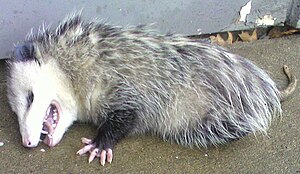
Back موت ظاهري Arabic Schreckstarre German Tanatosis Spanish Tanatosi Basque مردهنمایی Persian Valekuolema Finnish Thanatose French Tanatose Galician התחזות למת HE Կեղծ մահ Armenian


Apparent death[a] is a behavior in which animals take on the appearance of being dead. It is an immobile state most often triggered by a predatory attack and can be found in a wide range of animals from insects and crustaceans to mammals, birds, reptiles, amphibians, and fish.[1][5][2] Apparent death is separate from the freezing behavior seen in some animals.[1][2]
Apparent death is a form of animal deception considered to be an anti-predator strategy, but it can also be used as a form of aggressive mimicry. When induced by humans, the state is sometimes colloquially known as animal hypnosis. The earliest written record of "animal hypnosis" dates back to the year 1646 in a report by Athanasius Kircher, in which he subdued chickens.[6]
- ^ a b c Humphreys, Rosalind K.; Ruxton, Graeme D. (2018-01-15). "A review of thanatosis (death feigning) as an anti-predator behaviour". Behavioral Ecology and Sociobiology. 72 (2): 22. doi:10.1007/s00265-017-2436-8. ISSN 1432-0762. PMC 5769822. PMID 29386702.
- ^ a b c Sakai, Masaki, ed. (2021). Death-Feigning in Insects: Mechanism and Function of Tonic Immobility. Entomology Monographs. Singapore: Springer Singapore. doi:10.1007/978-981-33-6598-8. ISBN 978-981-336-597-1. S2CID 232415330.
- ^ Rogers, Stephen M.; Simpson, Stephen J. (2014). "Thanatosis". Current Biology. 24 (21): R1031–R1033. Bibcode:2014CBio...24R1031R. doi:10.1016/j.cub.2014.08.051. PMID 25517363. S2CID 235311966.
- ^ Rusinova, E. V.; Davydov, V. I. (2010-05-21). "Dynamics of Changes in Electrical Activity in the Rabbit Cerebral Cortex during Sequential Sessions of "Animal Hypnosis"". Neuroscience and Behavioral Physiology. 40 (5): 471–478. doi:10.1007/s11055-010-9283-7. ISSN 0097-0549. PMID 20490695. S2CID 20118773.
- ^ Miyatake, T.; Katayama, K.; Takeda, Y.; Nakashima, A.; Sugita, A.; Mizumoto, M. (2004-11-07). "Is death–feigning adaptive? Heritable variation in fitness difference of death–feigning behaviour". Proceedings of the Royal Society of London. Series B: Biological Sciences. 271 (1554): 2293–2296. doi:10.1098/rspb.2004.2858. ISSN 0962-8452. PMC 1691851. PMID 15539355.
- ^ Gilman, T.T.; Marcuse, F.L.; Moore, A.U. (1960). "Animal hypnosis: a study of the induction of tonic immobility in chickens". Journal of Comparative Physiology and Psychology. 43 (2): 99–111. doi:10.1037/h0053659. PMID 15415476.
Cite error: There are <ref group=lower-alpha> tags or {{efn}} templates on this page, but the references will not show without a {{reflist|group=lower-alpha}} template or {{notelist}} template (see the help page).